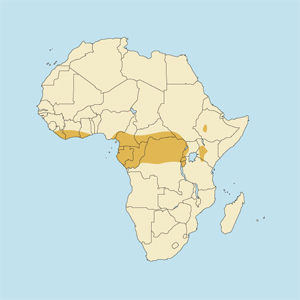 |
Hylochoerus meinertzhageni
Cerdo gigante de bosque (Sp), Riesenwaldschwein (G), Hylochère (F). Also called forest hog, which is not sufficiently definitive, as the bushpig and red river hog also live in forests. Named for soldier-naturalist Col. Richard Meinertzhagen (1878-1967), who was in East Africa from 1902 to 1905 and took the first specimen for science in 1904.
DESCRIPTION Shoulder height 38-43 inches (96-110 cm). Weight 400-600 pounds (180-275 kg).
The giant forest hog is the largest living pig species, huge and heavily built, with a long body and a rump that is higher than its shoulders. The massive head has a long flat snout, and below the eyes are gigantic warty growths (resembling funguses), which are some three times larger than those of the warthog. The ears are small and pointed. The body is covered with long, coarse, black hair. The hairs of the head and back of the neck are 6-7 inches (15-18 cm) in length and stand nearly erect, which gives the animal an intimidating appearance. The tusks, which emerge from the mouth horizontally and curve backward in the plane of the face, are small, barely protruding from the head. Females are similar to males but considerably smaller, with a slimmer, hairier face and much smaller tusks.
BEHAVIOR Lives in family groups of 4-12, sometimes in larger herds. Old males may be solitary. Seems to breed year-round, with young seen in all months. Litter size is 1-4, sometimes as many as eight. Older animals protect the young from predators.
Mainly nocturnal, but may also be diurnal where unhunted. Eats any vegetable matter, including crops. Prefers living where there is water and marsh; likes to wallow in water or mud. Does very little rooting for its food. Shy and wary. Hearing is very good, sense of smell is good, eyesight is moderate. Rests during the day in nest-like places in dense thickets that are reached by tunnels through the bush.
HABITAT Dense equatorial forests at any elevation.
DISTRIBUTION Lowland forests from eastern Liberia eastward to Togo. Then again, in lowland and gallery forests, from extreme eastcentral Nigeria, Cameroon and Gabon eastward through the southern Central African Republic, Congo (B) and Congo (K) to southwestern Sudan and southwestern Uganda. In mountain forests in west-central Ethiopia, Uganda, western Kenya and northern Tanzania. Probably fairly rare, though common in areas where they occur.
REMARKS Not an easy animal to hunt nor is it found in many collections; in fact, it is seldom seen at all. Not discovered by science until 1904. Once a group has been located and its habits learned, it can be productive to stalk or sit early or late in the day. But most giant forest hogs are taken as targets of opportunity while hunting elephant, bongo or other forest game.
TAXONOMIC NOTES Three subspecies are recognized, which we do not separate: ivoriensis (West African forest hog) from Guinea, Sierra Leone, Liberia, Ivory Coast and Ghana; rimator (Central African forest hog) from eastern Nigeria, Cameroon, Gabon, Congo (B), Central African Republic, southwestern Sudan and northeastern Congo (K); and meinertzhageni (eastern forest hog) from eastern Congo (K), Uganda, Rwanda, Burundi, northern Tanzania, southwestern Kenya and Ethiopia (the Ethiopian populations may prove to be a fourth subspecies).
|





